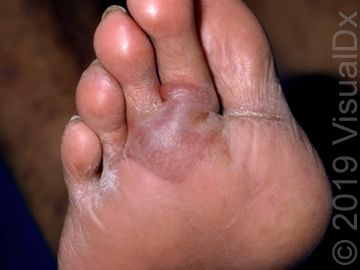Article
Image IQ: Diabetes and bulla on the foot
A 58-year-old man with a history of diabetes mellitus type 1 went to the urgent care after he awoke one morning and noticed the bottom of his foot near his toes felt funny. When he looked at the area, he realized that a bulla had formed on the bottom of his foot overnight. He hadn’t injured or cut the foot or leg recently, and he felt in good health otherwise. What's your diagnosis?
(©VisualDx)

A 58-year-old man with a history of diabetes mellitus type 1 went to the urgent care after he awoke one morning and noticed the bottom of his foot near his toes felt funny. When he looked at the area, he realized that a bulla had formed on the bottom of his foot overnight. He hadn’t injured or cut the foot or leg recently, and he felt in good health otherwise.
What's your diagnosis?
A. Cellulitis
B. Bullosis diabeticorum
C. Insect bite reaction
D. Blister
Use the differential builder on VisualDx to guide in your decision.
See the next page for the answer.
The correct answer is B.) Bullosis diabeticorum
Synopsis: Bullosis diabeticorum (BD), also known as bullous eruption of diabetes mellitus or diabetic bullae, occurs in about 0.5% of diabetic patients and has an unknown pathogenesis. The co-occurrence of neuropathy and nephropathy suggests an underlying microangiopathy. The bullae are noninflammatory and asymptomatic, and they typically develop rapidly.
BD develops in long-standing, uncontrolled diabetic patients, although there are reports of BD as the presenting sign of diabetes. Bullae often resolve on their own without scarring, but recurrence is common, and new bullae can continue to form over a period of years. The average age of onset is 55 years, and there is a 2:1 male-to-female ratio.
For more information about this diagnosis, visit VisualDx.





